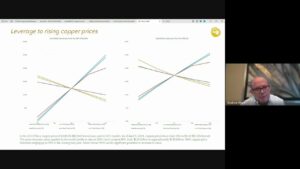TORONTO, ONTARIO, Jan 17, 2012 (MARKETWIRE via COMTEX) — Primero Mining Corp. (“Primero” or the “Company”) today announced 2011 annual production and provided production and cash cost guidance for 2012.
Highlights:
— Solid Production – Fourth quarter production of 23,100 gold equivalent
ounces(1) and annual 2011 production of 102,200 gold equivalent ounces;
— Strong Throughput – Average daily throughput increased to 2,050 tonnes
per day in the fourth quarter and 1,950 tonnes per day for 2011, an
increase of 8% over full year 2010;
— Steady Outlook – 2012 production forecast to be 100,000 to 110,000 gold
equivalent ounces;
— Review of Reserve and Resource Estimation Methods – Lack of
predictability between mine production and the historical mineral
reserve and resource model has prompted a review of the estimation
approach.
Total cash costs(2) for 2011 are expected to be $640 per gold equivalent ounce or $384 per gold ounce, net of by-product credits. The preliminary cash cost information provided is approximate and may differ from the final results that will be included in the Company’s 2011 annual audited financial statements and MD&A.
“San Dimas achieved a significant increase in throughput in 2011 and we met our revised production guidance for gold equivalent ounces. However, some operating results did not meet our expectations,” said Joseph F. Conway, President and C.E.O. “We have made solid progress in the last seventeen months, increasing daily throughput, improving underground mine development and controlling our costs per tonne to within 1% of budget. The principal reason we did not meet original production guidance was due to the lack of grade predictability which impacted our production. As a result, we are initiating a number of operational improvements as well as a review of our current reserve and resource estimation methods. The estimation method review is intended to assess whether use of other estimation methods may allow us to improve mine planning and more accurately predict actual production.
“Our 2012 forecast gold production of between 100,000 and 110,000 gold equivalent ounces reflects the lower ore grades we have recently encountered, and is one of the primary drivers behind our decision to significantly increase delineation drilling and review the resource estimation method historically used at the mine. We remain focused on growing production at San Dimas by continuing to optimize mine planning and still expect to complete a mine expansion within the next 24 months. We intend to provide an update on our three-year production plan upon completion of our 2011 reserve and resource estimation.
“In 2011 Primero demonstrated its ability to considerably improve its balance sheet strength and identify operational improvements, while clearly establishing its intention to grow by seeking out a material M&A transaction.”
Increased Throughput Results in Steady Production
Primero produced 23,100 gold equivalent ounces during the fourth quarter of 2011. This resulted in annual 2011 production of 102,200 gold equivalent ounces, within the revised guidance range of 100,000 to 110,000 gold equivalent ounces.
The Company produced 20,200 ounces of gold and 1.20 million ounces of silver in the fourth quarter 2011, 5% and 1% lower, respectively, than the fourth quarter 2010, due to lower grades (8% lower for gold and 6% lower for silver) partially offset by 4% higher throughput.
Production at San Dimas in 2011 was in-line with 2010 primarily as a result of mining more ore at lower grades. Mill throughput in 2011 increased by 8% over 2010 and averaged 1,950 tonnes per day. Throughout 2011, most of the production was from the deep Central Block area where grades in the Roberta and Robertita veins were below expectations. Gold grades in 2011 averaged 3.9 grams per tonne, 13% below 2010, while silver grades averaged 226 grams per tonne, 7% below 2010.
The Company was successful at controlling costs, keeping costs per tonne for 2011 to within 1% of budget. Total cash costs are expected to be $719 per gold equivalent ounce, or $580 per gold ounce on a by-product basis for the fourth quarter of 2011; and $640 per gold equivalent ounce, or $384 per gold ounce on a by-product basis for the full year 2011.
Summarized Operating Data
———————————————————————–
—–
Year Ended Three Months Ended
31-Dec- 31-Dec- 31-Dec- 30-Sep- 30-Jun- 31-Mar- 31-Dec-
11 10 11 11 11 11 10
—————————————————————————-
Operating Data(1)
Tonnes of ore milled 662,612 612,253 176,633 186,997 136,464 162,517 168,875
Average mill head
grade (grams/tonne)
Gold 3.86 4.46 3.70 3.35 4.56 4.03 4.01
Silver 226 244 223 195 259 250 236
Average recovery
rate (%)
Gold 97% 97% 98% 97% 97% 97% 97%
Silver 96% 94% 95% 94% 94% 94% 94%
Produced
Gold equivalent
(ounces) 102,224 100,266 23,115 27,450 27,576 24,083 24,771
Gold (ounces) 79,564 85,429 20,191 19,500 19,374 20,498 21,171
Silver (million
ounces) 4.60 4.53 1.20 1.10 1.06 1.23 1.21
Sold
Gold equivalent
(ounces) 100,138 99,685 21,192 27,633 26,807 24,506 30,480
Gold (ounces) 77,490 85,378 18,487 19,659 18,837 20,506 27,329
Silver (million
ounces) 4.63 4.37 1.11 1.11 1.03 1.37 1.06
Silver sold under
contract (million
ounces) 4.12 4.37 1.11 0.86 0.77 1.37 1.06
Silver sold at spot
(million ounces) 0.51 0.00 0.00 0.25 0.26 0.00 0.00
Average realized
price (per ounce)
Gold $1,561 $1,234 $1,679 $1,668 $1,523 $1,387 $1,359
Silver contract
price(2) $4.06 $4.04 $4.08 $4.04 $4.04 $4.04 $4.04
Silver spot price $36.78 – – $39.03 $34.59 – –
Silver(2) $7.69 $4.04 $4.08 $12.00 $11.73 $4.04 $4.04
Total cash costs
(per gold ounce)
(2),(3)
Gold equivalent
basis $640 $584 $719 $641 $586 $624 $645
By-product basis $384 $471 $580 $222 $190 $491 $524
—————————————————————————-
(1) The San Dimas Mine was acquired by Primero from Goldcorp Inc. on August
6, 2010. The operating data for the year ended December 31, 2010 was derived
partially from records maintained by Goldcorp Inc.
(2) Due to a silver purchase agreement originally entered into in 2004, all
silver produced prior to August 6, 2010 was sold at a fixed price. As a
result of restructuring the silver purchase agreement on August 6, 2010,
Primero sells a portion of silver production at spot prices, subject to
minimum threshold amounts being met(5).
(3) Total cash costs per gold ounce on a gold equivalent and by-product
basis are non-GAAP financial measures. Total cash costs per gold equivalent
ounce are defined as cost of production (including refining costs) divided
by the total number of gold equivalent ounces produced. Total cash costs on
a by-product basis are calculated by deducting the by-product silver credits
from operating costs and dividing by the total number of gold ounces
produced. The Company reports total cash costs on a production basis. In the
gold mining industry, these are common performance measures but do not have
any standardized meaning. As such, they are unlikely to be comparable to
similar measures presented by other issuers. In reporting total cash costs
per gold equivalent and total cash costs on a by-product basis, the Company
follows the recommendations of the Gold Institute standard. The Company
believes that, in addition to conventional measures, prepared in accordance
with GAAP, certain investors use this information to evaluate the Company’s
performance and ability to generate cash flow. Accordingly, it is intended
to provide additional information and should not be considered in isolation
or as a substitute for measures of performance prepared in accordance with
GAAP. A reconciliation of total cash costs per gold equivalent ounce and
total cash costs per gold ounce on a by-product basis to operating expenses
(the nearest GAAP measure) for the fourth quarter and year ended December
31, 2011 will be completed along with the year-end audit.
Outlook for 2012
In 2012 Primero expects to produce between 100,000 and 110,000 gold equivalent ounces in-line with 2011 production, based on higher throughput at lower grades. Cash costs for 2012 are expected to be in the range of $630 to $660 per gold equivalent ounce or between $310 and $340 per gold ounce on a by-product basis. Primero’s 2012 outlook is summarized in the following table.
———————————————————————–
—-
Outlook 2012
—————————————————————————
Gold equivalent production(1)(gold equivalent
ounces) 100,000-110,000
Gold production(ounces) 80,000-90,000
Silver production(3)(ounces) 4,500,000-5,000,000
Gold grade(grams per tonne) 3.7
Silver grade(grams per tonne) 225
Total cash costs(2)(per gold equivalent ounce) $630 – $660
Total cash costs(2) – by-product(per gold ounce) $310 – $340
Capital expenditures (US$ millions) $30 million
—————————————————————————
Material assumptions used to forecast total cash costs for 2012 include: an average gold price of $1,600 per ounce; an average silver price of $9.41 per ounce (calculated using the silver agreement contract price of $4.08 per ounce and assuming excess silver beyond contract requirements is sold at an average silver price of $30 per ounce); and foreign exchange rates of 1.05 Canadian dollars and 12.8 Mexican pesos to the US dollar.
Capital expenditures in 2012 are planned to remain steady, reflecting management’s continued focus on growth, with underground development and exploration drilling accounting for around 70% of the expected $30 million expenditure. This will include a Company record 65,000 metres of diamond drilling, consisting of 35,000 metres of delineation drilling and 30,000 metres of exploration drilling. Infrastructure drifting is expected to total 5,000 metres plus 3,000 metres of exploration drifting. The remainder of the capital expenditures in 2012 will be sustaining capital of $5.8 million plus capital projects of $4.1 million.
As a result of the Company undertaking a review of its reserve and resource estimation methods, the decision to expand the milling facility to 2,500 tonnes per day is expected to be deferred by no more than 12 months. Once the review is complete, detailed engineering will begin to determine the optimal mill size given the reserve and resource grade and the level of planned development. Should the reserve grade be below previous estimates, an expansion plan to process more than 2,500 tonnes per day may be necessary to achieve long term production targets.
Reserve and Resource Estimation Method Review
The San Dimas deposit is a well-known, high-grade, low sulphidation, epithermal gold-silver vein system. There are over 100 known high-grade veins in five ore zones or blocks. Deposits with large variability in grade, such as at San Dimas, are well known for encountering difficulties in defining reserve and resource grade with confidence.
Although the San Dimas geology has been studied in detail, mine production over the last decade has not closely matched annual budgeted or forecast tonnes or grades. Since acquiring the mine 17 months ago, Primero has continued to experience these variations. As a result, the Company is undertaking a review of the reserve and resource estimation methods currently, and historically, used at the mine in order to determine whether other estimation methods might be used to improve predictability of operating results and, therefore, assist long term planning.
The Company has retained AMC Consultants, an independent mining and geological consulting firm that has not previously reported on the property, to assist it in its review of the best estimation method applicable at San Dimas. The Company will reflect any changes that result from the review in an up-date of its National Instrument 43-101 compliant mineral reserve and resource statement.
The adoption of any new estimation methods may result in the Company reporting different and potentially lower total mineral reserve and total mineral resource numbers. It may also result in the reclassification of the Company’s mineral resources and mineral reserves, including potentially reporting categories of measured and indicated in addition to the currently reported categories of inferred mineral resources and proven and probable mineral reserves. However, it is not expected that any potential change in estimates will change the level of confidence management has in the ultimate mineral potential of San Dimas. As noted, the review of estimation methodology is being driven by a desire to determine if greater operating predictability and improved mine planning can be achieved.
Focused Exploration and Development Expected to Unlock Potential
Underground development in 2012 will again be focused in the main mining (Central Block) and exploration (Sinaloa Graben) blocks. In 2012 the majority of the ore is anticipated to come from the Central Block with approximately 20% from the higher-grade Sinaloa Graben block.
Although the current geological model has produced excellent exploration results over an extended period of time, the Company is working to improve it. Exploration target selection and prioritization for 2012 focuses on the mineralized veins that occur in the prolific central corridor of the district. This south-west to north-east trending corridor contains the Roberta and Robertita veins, both systems being noted for their thickness, high-grade and lateral extensions. A primary objective of 2012 is to examine the potential north-east and south-west extensions of the Roberta and Robertita vein systems. Previous workings at the San Fernando area of the mine to the north-east and the West Block to the south-west were also noted for above average grade and thickness.
This central corridor historically constitutes the most prolific trend in the district and therefore by focusing exploration efforts along this trend, the probability of discovering high-grade mineralization may be increased. The Company, as part of the geological model review, is also investigating the possibility that there is more than one horizon within the San Dimas mineralized system. If proven, there would be a possibility of detecting further mineralization in the current and historical working areas. Drilling is currently testing the possibility of a second mineralized horizontal band about 200 meters below the first one.
(1) “Gold equivalent ounces” include silver ounces produced, and converted to a gold equivalent based on a ratio of the average commodity prices realized for each period. The ratio for the fourth quarter was 412:1 based on the average realized prices of $1,679 per ounce of gold and $4.08 per ounce of silver. The ratio for full year 2011 was 203:1 based on the average realized prices of $1,561 per ounce of gold and $7.69 per ounce of silver. The ratio used for the 2012 guidance projection is 170:1 based on estimated average prices of $1,600 per ounce of gold and $9.41 per ounce of silver.
(2) Total cash costs per gold equivalent ounce and total cash costs on a by-product basis are non-GAAP measures. Total cash costs per gold equivalent ounce is defined as cost of production (including refining costs) divided by the total number of gold equivalent ounces produced. Total cash costs on a by-product basis are calculated by deducting the by-product silver credits from operating costs. The Company reports total cash costs on a production basis. In the gold mining industry, these are common performance measures but do not have any standardized meaning, and are non-GAAP measures. The Company follows the recommendations of the Gold Institute standard. The Company believes that, in addition to conventional measures, prepared in accordance with GAAP, certain investors use this information to evaluate the Company’s performance and ability to generate cash flow. Accordingly, it is intended to provide additional information and should not be considered in isolation or as a substitute for measures of performance prepared in accordance with GAAP.
(3) According to the silver purchase agreement between the Company and Silver Wheaton Corp., until August 6, 2014 Primero will deliver to Silver Wheaton a per annum amount equal to the first 3.5 million ounces of silver produced at San Dimas and 50% of any excess at $4.08 per ounce (increasing by 1% per year). Thereafter Primero will deliver to Silver Wheaton a per annum amount equal to the first 6.0 million ounces of silver produced at San Dimas and 50% of any excess at $4.20 per ounce (increasing by 1% per year). The Company will receive silver spot prices only after the annual threshold amount has been delivered.
About Primero
Primero Mining Corp. is a Canadian-based precious metals producer and owns 100% of the San Dimas gold-silver mine in Mexico. Primero is focused on delivering superior, sustainable value for all stakeholders with low-risk exposure to gold. The Company intends to become an intermediate gold producer by building a portfolio of high quality, low cost precious metals assets in the Americas.
Primero’s website is www.primeromining.com .
TECHNICAL INFORMATION AND QUALIFIED PERSON/QUALITY CONTROL NOTES
The scientific and technical information contained herein is based on information prepared by or under the supervision of Mr. Joaquin Merino-Marquez, Vice President, Exploration, Primero Mining Corp., who is a “Qualified Person” for the purposes of National Instrument 43-101 Standards of Disclosure for Mineral Projects (“NI 43-101”).
CAUTIONARY STATEMENT ON FORWARD-LOOKING INFORMATION
This news release contains “forward-looking statements”, within the meaning of the United States Private Securities Litigation Reform Act of 1995 and applicable Canadian securities legislation, concerning the business and operations of Primero Mining Corp. and its consolidated subsidiaries (collectively, “Primero” or the “Company”). All statements, other than statements of historical fact, are forward-looking statements. Generally, forward-looking statements can be identified by the use of forward-looking terminology such as “plans”, “expects”, “is expected”, “budget”, “scheduled”, “estimates”, “forecasts”, “intends”, “anticipates”, “believes” or variations of such words and phrases or statements that certain actions, events or results “may”, “could”, “would”, “might” or “will be taken”, “occur” or “be achieved” or the negative connotation thereof.
Forward-looking statements in this press release include, but are not limited to, statements regarding the Company’s total cash costs for the fourth quarter and year-end of 2011; the level of gold equivalent production at San Dimas; the realization of silver sales at spot prices; the amount of gold equivalent ounces production in 2012, the cash costs for 2012; the capital expenditures in 2012; the underground development in 2012; the amount of ore from the Company’s operations in 2012; the probability of encountering high grade mineralization in, and the exploration potential of, the Company’s exploration targets; the potential changes to the method of estimating, and the estimation of, mineral reserves and resources; the potential improvements in operating predictability and mine planning and estimating future cash flows from operations; and the Company’s intentions to become an intermediate gold producer.
The assumptions made by the Company in preparing the forward-looking information contained in this news release, which may prove to be incorrect, include, but are not limited to: the expectations and beliefs of management; the specific assumptions set forth above in this press release; that there are no significant disruptions affecting operations; that development and expansion at San Dimas proceeds on a basis consistent with current expectations and the Company does not change its development and exploration plans; that the exchange rate between the Canadian dollar, Mexican peso and the United States dollar remain consistent with current levels or as set out in this press release; that prices for gold and silver remain consistent with the Company’s expectations; that production meets expectations; that the silver purchase agreement allows the Company to realize silver sales at spot prices in 2012; that the Company identifies higher grade veins in sufficient quantities of minable ore in the Central Block and in Sinaloa Graben; that the geology and vein structures in Sinaloa Graben are as expected; that the ratio of gold to silver price is maintained in accordance with the Company’s expectations; that there are no material variations in the current tax and regulatory environment; that the Company will receive required permits and access to surface rights; that the Company can access financing, appropriate equipment and sufficient labour; that any new resource estimation methods adopted by the Company improve operating predictability, mine planning and estimating of future cash flows from operations and that the political environment within Mexico will continue to support the development of environmentally safe mining projects.
Forward-looking statements are subject to known and unknown risks, uncertainties and other important factors that may cause the actual results, performance or achievements of Primero to be materially different from those expressed or implied by such forward-looking statements, including: the Company may not be able to achieve planned production levels; the Company may not be able to expand production at San Dimas, the Company may not be able to fund exploration and development expenditures; the Company may re required to change its development and exploration plans with a negative impact on production; the Company may not discover mineralization in minable quantities; the exchange rate between the Canadian dollar, the Mexican peso and the United States dollar may change with an adverse impact on the Company’s financial results; the Company may not be able to complete a review of its methodology for preparing resource and reserve estimates and produce an up-dated National Instrument 43-101 compliant mineral reserve and resource statement within the contemplated time frame; any new resource estimation method may not improve operating predictability, mine planning and estimation of future cash flows from operations; the Company may not be able to become an intermediate gold producer by building a portfolio of high quality, low cost precious metals assets in the Americas. Certain of these factors are discussed in greater detail in Primero’s registration statement on Form 40-F on file with the U.S. Securities and Exchange Commission, and its most recent Annual Information Form on file with the Canadian provincial securities regulatory authorities and available at www.sedar.com .
Should one or more of these risks and uncertainties materialize, or should underlying assumptions prove incorrect, actual results may vary materially from those described in forward-looking statements. In addition, although Primero has attempted to identify important factors that could cause actual actions, events or results to differ materially from those described in forward-looking statements, there may be other factors that cause actions, events or results not to be as anticipated, estimated or intended. There can be no assurance that such statements will prove to be accurate, as actual results and future events could differ materially from those anticipated in such statements. Accordingly, readers should not place undue reliance on forward-looking statements.
Forward-looking statements are made as of the date hereof and accordingly are subject to change after such date. Forward-looking statements are provided for the purpose of providing information about management’s current expectations and plans and allowing investors and others to get a better understanding of our operating environment. Primero does not undertake to update any forward-looking statements that are included in this document, except in accordance with applicable securities laws.
Contacts:
Primero Mining Corp.
Tamara Brown
VP, Investor Relations
(416) 814 3168
[email protected]www.primeromining.com
SOURCE: Primero Mining Corp.
mailto:[email protected]http://www.primeromining.com
























